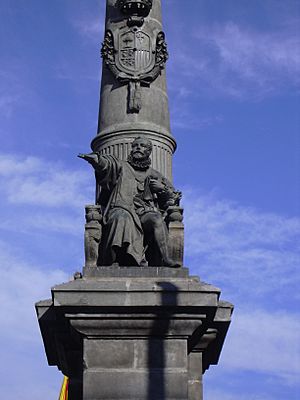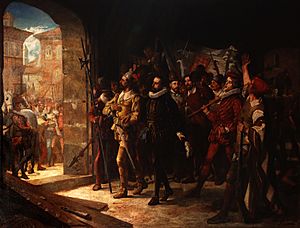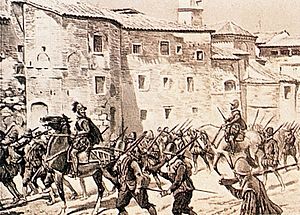Alterations of Aragon facts for kids

The Alterations of Aragon were important events that happened in Aragon during the rule of King Philip II. While other parts of Spain like Castile and Valencia had their own rebellions, Aragon stayed mostly peaceful in the early 1500s. These "Alterations" were a series of disagreements and conflicts between the King's power and the special laws (called fueros) of Aragon.
Contents
Why the Troubles Started
Since the Inquisition was set up in 1478, kings had been trying to gain more control. Philip II, son of Charles I, continued this trend. This led to early problems in places like Teruel and Albarracín. People there were unhappy with how the King's representatives and the Inquisition acted.
Early Conflicts in Aragon
The city of Teruel was even surrounded by the King's army in 1572. After some fighting, the city gave up. The leaders of this revolt were punished.
Aragon already had other problems. There were issues in the Ribagorza area and unfair treatment of common people by their lords. People in Zaragoza also protested against certain rules. There were also fights between highlanders and Moriscos (Muslims who had converted to Christianity).
The Case of Antonio Pérez
In 1590, a man named Antonio Pérez came to Aragon. He had been King Philip II's secretary but was arrested in 1579. He was accused of serious crimes and of betraying the King's trust.
Pérez escaped from prison in Madrid and fled to Zaragoza. He sought protection under Aragon's special laws, especially the Privilege of Manifestation. This law meant Aragonese courts would protect him. He found support from some important Aragonese nobles.
King Philip II didn't trust the Aragonese courts to punish Pérez. So, he used the Inquisition against him. The Inquisition was a powerful religious court. Pérez was accused of speaking against God, which was considered heresy. This was a way for the King to get around Aragon's laws.
Key Events of 1591
The conflict grew more intense in 1591.
The May 24th Riot
On May 24, 1591, the Aragonese Justice, following the Inquisition's request, ordered Antonio Pérez to be moved to an Inquisition prison. However, Pérez's supporters attacked the King's representative, the Marquis of Almenara, who later died.
The rioters then went to the Inquisition prison. They used threats to get Pérez back to the prison protected by Aragonese law. The Inquisition warned people about harming their officials. But the rioters responded with more threats.
When King Philip II heard about the riot, he ordered his army to gather near Aragon. He also sent a letter to Aragonese towns, asking for calm. Most towns condemned the riot and asked for the rioters to be punished. This left Zaragoza isolated.
Aragon's leaders decided that Pérez should be returned to the Inquisition. But the rioters used threats and violence again, stopping the transfer. Pérez then tried to escape from prison. The Justice ordered him moved to a safer jail.
The September 24th Riot
After much planning, the Aragonese authorities decided to move Antonio Pérez to the Inquisition prison on September 24. Just two days before, the Justice of Aragon, Juan de Lanuza y Perellós, died. His son, Juan de Lanuza y Urrea, who was only 26, took his place.
On the planned day, the governor closed the city gates. This left many farmers stuck in the city. The governor threatened anyone who opposed the transfer. When a young man shouted for "liberty," he was shot. This made Pérez's supporters ring the bell of San Pablo church, a signal for revolt.
The new Justice and other Aragonese leaders agreed that Pérez should be moved. But a large crowd had gathered outside the prison. When the Inquisition's carriages arrived, Pérez's supporters attacked the guards. Some guards even joined the rebels. The authorities fled.
The crowd set fire to a house where the governor was hiding. They threatened to burn the jail too. The jailers let Antonio Pérez out. Pérez and his supporters escaped the city and headed towards France. More than 30 people died in these riots. After Pérez left, the riots calmed down.
When King Philip II heard what happened, he decided to send his army into Aragon. He wanted to restore order and the authority of the Inquisition. He also ordered Aragonese authorities to secure or destroy weapons so they wouldn't fall into the rioters' hands.
Antonio Pérez, unable to reach France, secretly returned to Zaragoza. He encouraged the rebels, telling them the King's army would take away their special laws. The Aragonese authorities ignored the King's order and gave weapons to the rebels. The rebels took control of Zaragoza.
The Royal Army Enters Aragon
The news that the King's army was coming shocked Aragon. Pérez's supporters demanded that the Aragonese leaders declare this an attack on their laws. They wanted armed resistance against the King.
Aragonese Resistance
Aragonese lawyers said that an outside army entering to enforce justice went against their laws. The Justice of Aragon agreed and ordered resistance against the royal troops. This meant Aragon's leaders formally declared war on their own King.
This declaration was made public on November 1st. Aragonese towns and lords were asked to send forces to Zaragoza. They hoped for an army of about 24,000 men, which would be larger than the King's army. They also asked for help from Catalonia and Valencia.
The King argued that his army was not entering to take away their laws. Instead, he said it was to help Aragonese authorities restore order. The Aragonese leaders stood by their decision. So, the King ordered his general, Alonso de Vargas, to prepare to enter Aragon.
Lack of Support for the Rebels
In Zaragoza, many seemed to support resistance, especially while Pérez's followers were there. But in the rest of Aragon, people were unsure. They wondered why the same people who had ignored the Justice's orders to return Pérez to the Inquisition now asked for support against the King.
Some towns sent small forces to Zaragoza, but far fewer than expected. Most cities told the Justice they would not fight the King to protect those who broke their own laws. Lords outside Zaragoza also did not send help. Some even helped the royal army with supplies. Catalonia and Valencia did not send reinforcements either.
The Justice named Pérez's supporters as captains of his forces. These were the same people who had rebelled against the Justice before. The King's army entered Aragon on November 7th and 8th. It had 12,000 foot soldiers, 2,000 horsemen, and 25 cannons.
The Justice's force, which left Zaragoza on November 8th, was only about 2,000 men. They were much smaller, less experienced, and not as well-equipped as the King's army. The royal army advanced without any problems. Local lords even helped them. The King's general made sure his army behaved well.
The Justice had ordered a bridge to be destroyed to slow the King's army. But his orders were ignored. The royal army found the bridge untouched. The Justice and his forces were in Utebo. When the Justice learned that the royal troops were heading straight for Zaragoza, he knew his small, undisciplined force couldn't win. He decided to abandon his troops and flee. Antonio Pérez and his main supporters also fled to France.
The King's army entered Zaragoza without opposition on November 12, 1591.
Aftermath and Changes
Pérez's followers tried to return to Aragon with help from King Henry IV of France, but they were stopped. Some of their leaders were captured and punished. Juan V de Lanuza, the young Justice, returned to Zaragoza. He was captured and executed by King Philip II's personal order without a trial. Many other leaders of the revolt faced a similar fate. Pérez escaped to France and later to England, where he spread negative stories about the King. He died in 1611.
Agreement with Aragon's Leaders
In 1592, Philip II called a meeting with the leaders of Aragon in Tarazona. No Aragonese institutions were completely removed, but they were changed. The King could now appoint a viceroy (a royal governor) who was not from Aragon. The Deputation of the Kingdom (a committee of Aragon's government) lost some control over money and local watch. It also lost its power to call representatives from cities.
The King could now remove the Justice of Aragon from his position. The Court of Justice was also placed more under the King's control. Finally, some parts of Aragon's legal system were changed. In December 1593, after these changes, King Philip II's troops left Aragon.
Most historians agree that the agreement was a compromise between the nobles and the King. The nobles preferred to accept the King's authority to protect their own special rights, even if they gave up some power. It is also believed that Philip II could have completely ended Aragon's special laws. He had an army, and the rebels had little support. But he didn't.
There were several reasons for this. Philip II, even as an absolute monarch, preferred to rule through viceroys and councils. Ending Aragon's laws might have meant doing the same in Catalonia and Valencia, which had been loyal to him. The Crown of Aragon was also facing economic problems, and its leaders usually granted the King the money he asked for. The King also held the most power in the richest parts of his kingdom: Castile and the Americas. However, he did use this chance to reduce some of the Aragonese nobility's power by limiting their special laws.
See Also
 In Spanish: Alteraciones de Aragón para niños
In Spanish: Alteraciones de Aragón para niños
- Diputación del General del Reino de Aragón
- Justicia de Aragón



